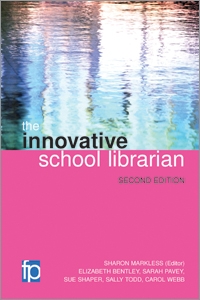
Primary tabs
You don't need to be an ALA Member to purchase from the ALA Store, but you'll be asked to create an online account/profile during the checkout to proceed. This Web Account is for both Members and non-Members.
If you are Tax-Exempt, please verify that your account is currently set up as exempt before placing your order, as our new fulfillment center will need current documentation. Learn how to verify here.
- Description
- Table of Contents
- About the authors
- Reviews
Taking a strategic approach to the leadership of school libraries, this book raises important questions about the functions of the school librarian and sets out to encourage the reader to think outside the box for new approaches to traditional challenges. It aims to inspire and enable school librarians to think creatively about their work and the community in which they operate. Written by current leaders in the field, each chapter addresses the practical issues facing school librarians. This new edition has been fully updated to incorporate curriculum revisions, resource changes, developments in the use and integration of technology and new routes into the profession. Key topics covered include:
- the librarian's vision and values;
- bridging the gap between different visions for the school library;
- identifying and understanding your community;
- making a positive response to change;
- keeping inspired and inspiring others in the library; and
- integrating the library into teaching and learning.
This is an essential, thought-provoking book for all school librarians, practitioners in schools library services, and students of librarianship. It has plenty to interest school leadership, headteachers, educational thinkers, public library managers and local government officers and also has an international audience.
1. Professionalism and the school librarian
2. How others see us
3. Bridging the gap between how we see ourselves and how others see us
4. Identifying and understanding your community
5. Making a positive response
6. Generating and using evidence of impact
7. Inspiration
8. Becoming integral to teaching and learning
9. Innovation
Appendix 1: Levels of education
Appendix 2: School library self-evaluation questions
Appendix 3: An example of a completed self-evaluation summary sheet
Appendix 4: SWOT analysis
Appendix 5: Choosing priorities in development planning
Appendix 6: Example of a force field analysis: a tool for managing change
Appendix 7: Managing change: process and principles
Sharon Markless
Sharon Markless is Senior Lecture in Higher Education within King's Learning Institute where she draws on many years of experience in both teaching and research. She initially taught in secondary schools and further education before moving into H.E. in 1990 as a Senior Lecturer in Professional Development at Canterbury Christ Church University College.
Elizabeth Bentley
Elizabeth Bentley is Librarian and Learning Resource Centre Manager at Addey and Stanhope School.
Sarah Pavey
Sarah Pavey has worked as a school librarian for over 20 years and is founder of education training company and consultancy SP4IL. She holds degrees in biochemistry and information science and is an established author and regular speaker at conferences for school libraries as well as wider education issues. Sarah is a Fellow of CILIP and the Royal Society of Arts and works with the Electronic Platform for Adult Learning in Europe (EPALE) in the field of adult education. Her training courses, both home and abroad, on a range of topics including playful learning, are practical and acclaimed for being rooted in theory.
Sally Todd
Sally Todd is School Archivist at St John's School.
Sue Shaper
Sue Shaper is Director of Library Resources at The Broxbourne School.
Dr. Carol Webb
Dr. Carol Webb is Head Librarian at Portsmouth Grammar School.
"The format of this second edition is apparently similar to that of the first (2009), with the regular use of short scenarios or ‘vignettes'. The first of these heads the preface, and others are then used frequently within each chapter to illustrate new subjects. This approach is designed to increase the readability of the text (in which it succeeds) while aiming to offer examples of ‘real-life' everyday situations for those managing libraries in secondary schools. The contributors note that the vignettes are drawn from comments and queries on the popular School Librarian Network, and this gives them a ring of authenticity."
— Ariadne


